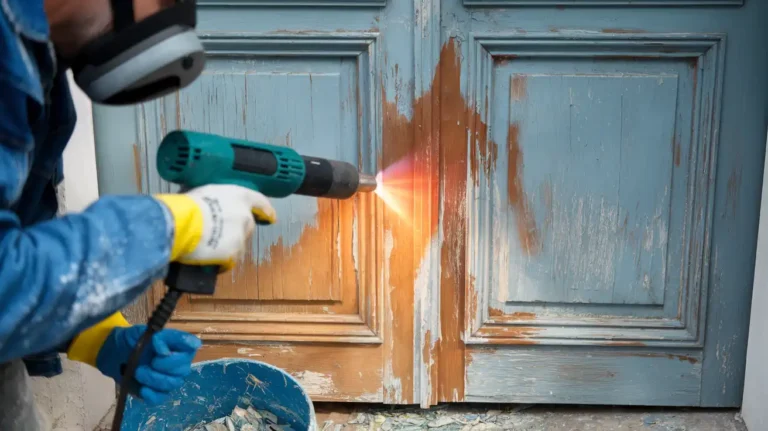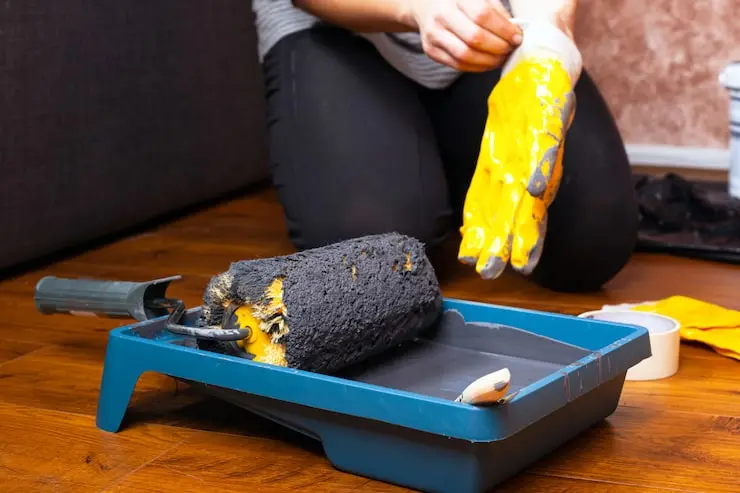Stripping old paint from metal isn’t rocket science, but doing it wrong can waste your time and money. Whether you’re restoring vintage furniture or prepping outdoor railings, knowing how to remove paint from metal properly makes all the difference. You have several proven methods to choose from, including mechanical scraping, chemical strippers, heat guns, and eco-friendly solutions.
This guide walks you through every method with real costs, safety tips, and step-by-step instructions. You’ll learn which technique works best for your specific project and how to avoid damaging the metal surface underneath.
Table of Contents
Identifying Your Paint Type Before You Start
Before you grab any tools, figure out what type of paint you’re dealing with. Oil-based paint feels smooth and glossy when dry. Latex paint has a rubbery texture and peels in strips. Enamel paint creates a hard, glass-like finish that’s tougher to remove.
Test a small hidden area first. Apply a drop of rubbing alcohol on a cotton swab. If the paint softens, it’s latex. If nothing happens, you’re working with oil-based or enamel paint.
Homes built before 1978 might have lead paint. Buy a lead test kit from any hardware store for about $10. If the test shows positive, hire a professional or use wet methods that minimize dust. Lead paint poses serious health risks, especially when you create airborne particles through sanding or dry scraping.
Step-by-Step Guide For How To Remove Paint From Metal
Start by cleaning the metal surface with soap and water. Remove all dirt, grease, and loose debris. This helps you see the paint layers clearly and improves removal effectiveness. A clean surface also ensures chemical strippers and other methods work at full strength.
Choose your removal method based on these factors: metal type, paint thickness, project size, and your budget. Small items like door hinges work well with chemical strippers or boiling water. Large outdoor pieces benefit from mechanical methods like angle grinders or pressure washers.
Always work in a well-ventilated area. Set up drop cloths to catch paint chips and protect surrounding surfaces. Wear safety goggles, heavy-duty gloves, and a dust mask at minimum. These basic safety measures prevent injuries and chemical exposure.
Test your chosen method on a small, hidden section first. This prevents damage to the entire piece if something goes wrong. A two-inch test spot takes five minutes but can save hours of regret.
Mechanical Paint Removal Methods
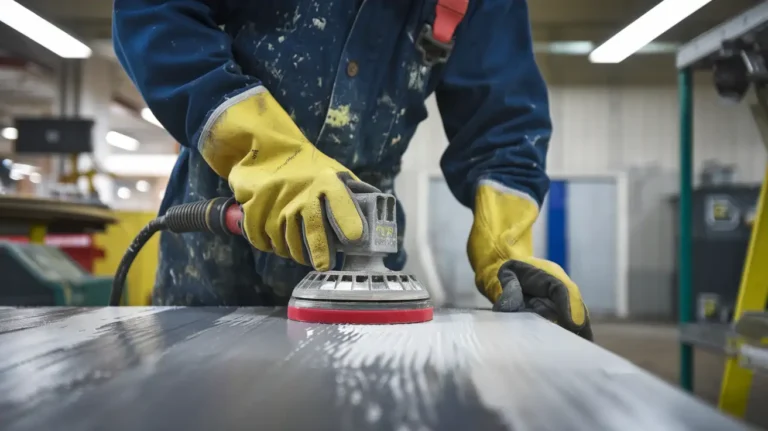
Mechanical methods use physical force to strip paint. They’re fast and don’t involve chemicals, but require more elbow grease and careful technique.
Paint Scraper Technique
A basic paint scraper costs $8 to $15 and works great on flat surfaces. Hold it at a 45-degree angle and push firmly across the painted area. Work in small sections to maintain consistent pressure. This method shines when paint is already flaking or bubbling. Sharp blades remove paint faster, so replace dull scrapers or sharpen them regularly.
Wire Brushes for Textured Surfaces
Wire brushes cost $5 to $12 and excel at removing paint from textured or curved metal pieces. Use circular motions with moderate pressure. Steel wire brushes work perfectly on iron and steel without causing damage. Switch to softer brass brushes for aluminum to avoid scratching the surface. Hand wire brushes give you control on delicate areas, while drill-mounted wire wheels speed up larger jobs.
Angle Grinder With Strip Disk
An angle grinder with a strip disk runs $50 to $120 for the tool plus $10 to $20 per disk. This combination removes paint fast from large metal surfaces like fences and outdoor furniture. Keep the grinder moving constantly to prevent gouging the metal underneath. Work at a slight angle rather than pressing flat against the surface. Wear hearing protection because grinders create loud noise levels.
Sanding for Fine Control
Sandpaper or sanding blocks cost $3 to $8 per pack. Start with 80-grit for heavy paint buildup, then move to 120-grit for smoothing. This method takes longer but gives you precise control over delicate areas and intricate details. Wet sanding reduces dust and prevents the sandpaper from clogging with paint residue.
Chemical Methods for Paint Removal
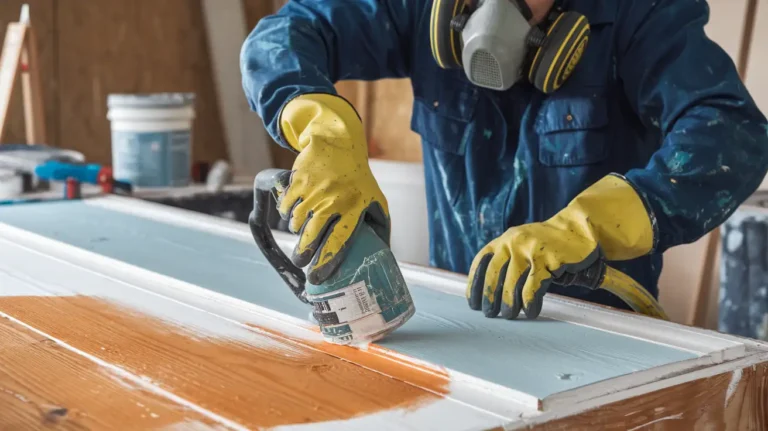
Chemical paint strippers dissolve paint bonds, making removal easier on complex shapes and stubborn layers. They work particularly well on vertical surfaces and detailed metalwork where mechanical methods struggle.
Commercial Paint Stripper Application
Commercial paint strippers cost $15 to $40 per quart. Apply a thick coat with a chip brush, making sure you cover all painted areas completely. Wait 30 minutes to overnight, depending on the product and paint thickness. The paint will bubble and lift away from the metal. Scrape away the loosened material with a putty knife, then wipe the surface clean with mineral spirits.
Choose methylene chloride-based strippers for fastest results, but only use them outdoors. They’re powerful but release strong fumes that can cause dizziness in enclosed spaces. N-methylpyrrolidone (NMP) strippers cost slightly more but work safely indoors with good ventilation. Some newer gel formulas cling to vertical surfaces better than liquid strippers.
Always read the label carefully. Some chemical paint strippers work only on latex paint, while others handle oil-based coatings. Using the wrong type wastes time and money. Temperature matters too. Most strippers work best between 60 and 85 degrees Fahrenheit.
Mineral Spirits Technique
Mineral spirits cost $10 to $15 per gallon and work well for thin paint layers or touch-up areas. Soak a clean rag and rub the painted surface in circular motions. The paint softens and wipes away gradually. This gentle approach suits delicate metal pieces like decorative hardware or antique fixtures. You can also use mineral spirits to clean up residue after using stronger paint removers.
Natural and Eco-Friendly Paint Removal Options
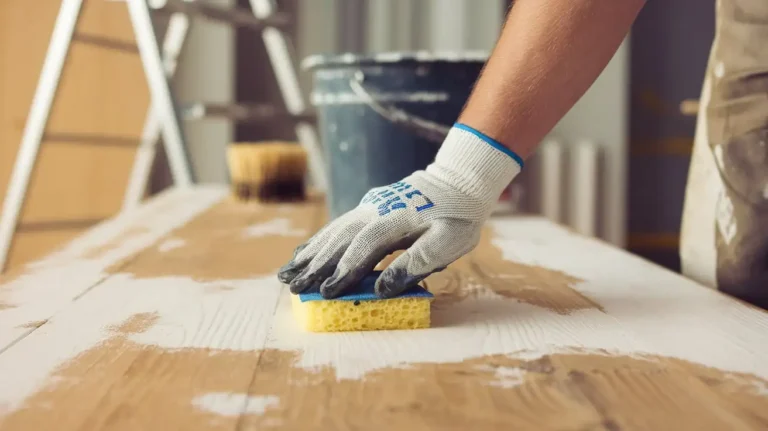
Eco-friendly methods skip harsh chemicals while still getting results. They take longer but create less environmental impact and work safely around children and pets.
Vinegar and Baking Soda Solution
Make a vinegar and baking soda solution for small metal items like hinges, brackets, and cabinet hardware. Mix equal parts white vinegar and water in a disposable pot. Add one-quarter cup baking soda per quart of liquid. Bring it to a boil, then submerge your metal pieces for 15 minutes. The paint loosens and scrapes off easily with minimal effort. Total cost runs under $5 for materials. This method works best on latex paint rather than oil-based coatings.
Citrus-Based Paint Removers
Citrus-based paint removers use d-limonene extracted from orange peels. They cost $20 to $35 per quart and smell pleasant compared to chemical strippers. Apply generously with a brush, wait 30 minutes to several hours, then scrape away the softened paint. These work indoors without overwhelming fumes or harsh odors. Citrus removers are biodegradable and safer for septic systems.
Soy Gel Strippers
Soy gel strippers run $25 to $45 per quart. They’re biodegradable and low in volatile organic compounds. Brush on a thick layer, cover with plastic wrap to prevent drying, and let sit overnight. The gel clings well to vertical surfaces without dripping. Soy-based formulas work on multiple paint layers and handle both latex and oil-based paints. They’re safe for indoor and outdoor use.
Heat-Based Paint Removal Techniques
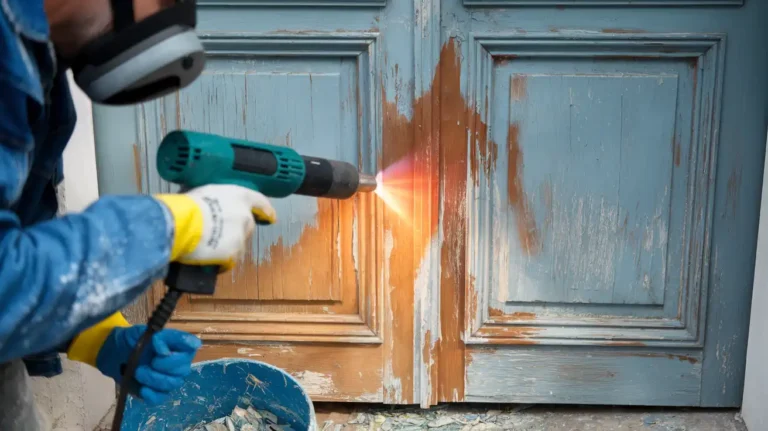
Heat softens paint so it peels away from metal. These methods work fast but require careful temperature control to avoid warping or discoloring the metal surface.
Using a Heat Gun
A heat gun costs $25 to $60 for basic models or $80 to $150 for professional versions with variable temperature controls. Set it to low heat first, around 400 to 500 degrees. Hold the gun 6 to 8 inches from the surface and move it slowly back and forth in sweeping motions. When paint bubbles, scrape it off immediately with a putty knife before it cools and hardens again.
Never overheat the metal. High temperatures can warp thin aluminum or cause discoloration on stainless steel. Work in small sections about six inches square. Keep the heat gun moving constantly to distribute heat evenly. Take breaks every 10 minutes to let the metal cool slightly.
Boiling Water Method
The boiling water method costs nothing and works perfectly for small items like hinges, brackets, and decorative hardware. Fill a pot with water and bring it to a rolling boil. Drop in your metal pieces and wait 15 minutes. The heat softens the paint bonds, and the paint peels right off. Use tongs to remove items safely from the hot water. Scrape away any remaining paint while the metal is still warm.
Specialized Paint Removal Techniques for Different Metal Types
Different metals need different approaches to avoid damage. Understanding your metal type prevents costly mistakes and ensures the best way to remove paint from metal without causing harm.
Removing Paint from Aluminum
Aluminum is soft and scratches easily compared to steel or iron. Use plastic scrapers instead of metal ones to protect the surface. Stick with chemical strippers specifically rated for aluminum or citrus-based removers. Avoid wire brushes and aggressive sanding that leave permanent scratches. The cost for aluminum-safe strippers runs $20 to $30 per quart. Work gently and patiently. Rushing with aluminum often creates more problems than it solves.
Stripping Paint From Cast Iron
Cast iron handles rough treatment well thanks to its thick, durable construction. Wire brushes, grinders, and strong chemical strippers all work fine. Apply a rust converter to any rusty spots before removing paint. This saves time and prevents rust from spreading. Coat the bare metal with rust-inhibiting primer immediately after stripping to prevent oxidation. Cast iron rusts quickly when exposed to moisture, sometimes within hours.
Paint Removal From Stainless Steel
Stainless steel requires gentle handling to maintain its corrosion-resistant properties. Use non-abrasive chemical strippers and plastic scrapers only. Never use steel wool or harsh wire brushes that scratch the protective chromium layer on the surface. These scratches create rust spots that spread over time. Rinse thoroughly with clean water after stripping and dry completely to prevent water spots.
Steel and Iron Surface Treatment
Steel and iron respond well to any removal method. These workhorse metals tolerate heat, chemicals, and mechanical scraping without damage. You can use aggressive techniques like angle grinders and strong chemical strippers without worry. Just protect them from rust once the paint comes off. Apply primer within a few hours of stripping to prevent surface oxidation.
Post-Removal Metal Treatment
Bare metal needs protection right away to prevent rust and corrosion. Exposed metal starts reacting with moisture in the air immediately after you remove the paint.
Cleaning the Bare Metal Surface
Clean the surface thoroughly after paint removal. Wipe it down with mineral spirits to remove chemical residue and oils left behind from the stripping process. Use a degreaser if the metal feels greasy or shows oily fingerprints. Rinse with clean water and dry completely with lint-free cloths. Any moisture left on bare metal triggers rust formation within hours.
For intricate pieces with crevices, use compressed air to blow out dust and debris. Cotton swabs dipped in mineral spirits clean tight corners that rags can’t reach. A perfectly clean surface ensures primers and paints bond properly.
Preventing Rust and Corrosion
Apply rust inhibitor or metal primer within hours of removing paint. Exposed iron and steel start oxidizing immediately when moisture hits them. A quality primer costs $15 to $25 per quart and creates a protective barrier against moisture and air. Spray primers work faster for detailed pieces with complex shapes.
For items you want to keep unpainted, apply paste wax or clear metal sealant. Paste wax costs $8 to $15 and needs reapplication every few months, especially on outdoor pieces. Clear sealant runs $12 to $20 and lasts longer, typically six months to a year. Apply multiple thin coats rather than one thick coat for better protection.
Store stripped metal indoors or in dry areas until you’re ready to paint or seal it. Even overnight exposure to humid air can create surface rust on bare iron and steel.
Essential Safety Precautions for Paint Removal
Safety matters more than speed when stripping paint from metal. Taking shortcuts with protective gear leads to injuries and health problems.
Required Protective Gear:
- Chemical-resistant gloves ($8 to $15 per pair) when handling paint strippers
- Safety goggles ($5 to $12) to protect eyes from flying paint chips and chemical splashes
- Dust mask or respirator ($1 for disposable masks, $25 to $50 for reusable respirators)
- Long sleeves and pants to shield skin from chemicals and sharp paint edges
- Hearing protection ($10 to $25) when using angle grinders or other power tools
- Heat-resistant gloves ($12 to $20) for handling hot objects after heat gun use
Work outdoors whenever possible. Fresh air disperses chemical fumes naturally and reduces health risks. If you must work indoors, open all windows and set up fans for cross-ventilation. Point one fan into the room and another out to create airflow. Chemical fumes concentrate quickly in closed spaces and can cause headaches, dizziness, and nausea.
Lead Paint Safety Measures
Lead paint requires extra precautions. Never sand, scrape dry, or use heat guns on lead paint. These methods create dangerous dust particles that you can inhale or that settle on surfaces. Wet scraping and chemical strippers minimize lead particle release. Better yet, hire a certified lead remediation specialist for large areas.
Keep children and pets away from your work area during paint removal and cleanup. Paint chips and chemical residue pose serious health risks. Seal off doorways with plastic sheeting when working indoors. Clean up thoroughly each day rather than letting debris accumulate.
Disposing of Removed Paint Safely
Proper disposal protects the environment and keeps you legal.
Collect all paint chips in heavy-duty plastic bags. Seal them tightly and label them clearly. Never dump paint waste in regular trash without checking local rules first.
Most cities have hazardous waste collection days or permanent drop-off sites. Call your local waste management office for schedules and locations. Some areas charge $5 to $15 per container for disposal.
Chemical strippers and mineral spirits need special handling. Pour leftover stripper back into its original container and seal it tight. Take it to a hazardous waste facility. Empty containers can go in regular recycling after they dry completely.
Used rags soaked in chemical strippers can spontaneously combust. Lay them flat outdoors to dry before disposal, or store them in a metal can filled with water.
Real Cost Breakdown for Paint Removal Projects
Budget planning helps you choose the best method for your situation.
- Small project (door hinges, brackets): $10 to $30 using vinegar solution or mineral spirits. Time investment: 1 to 2 hours.
- Medium project (metal chair, small gate): $40 to $80 using chemical stripper and scrapers. Time investment: 3 to 5 hours.
- Large project (metal fence, outdoor furniture set): $150 to $300 for angle grinder, disks, and safety gear. Time investment: 1 to 2 full days.
Professional paint stripping services cost $2 to $8 per square foot. A typical outdoor metal fence section (4 feet by 8 feet) runs $64 to $256 professionally versus $50 to $100 doing it yourself.
When to Call a Professional
Some situations demand expert help.
- Lead paint on large surfaces needs certified professionals. They have specialized equipment and disposal permits that DIYers can’t access.
- Intricate antiques or valuable metal pieces risk damage from amateur stripping. Professionals use gentler methods that preserve details and finish quality.
- Commercial or industrial equipment often has specialized coatings that standard removal methods won’t touch. Industrial paint stripping facilities use techniques like sandblasting and chemical dipping.
- If you’ve tried multiple methods without success, professionals save you time and frustration. They can identify paint types and choose effective removal strategies quickly.
Conclusion
Learning how to remove paint from metal opens up countless restoration and refinishing possibilities. You now have multiple proven methods to choose from based on your specific project needs, budget, and metal type. Start with the safest, simplest approach for your situation and scale up only if needed.
Remember that proper safety measures and disposal practices protect both you and the environment. Take your time, test methods on small areas first, and don’t rush through preparation steps.
For larger projects or when you need expert results, San Diego Home Remodeling brings professional experience to every metal restoration job. Our team handles everything from antique furniture refinishing to commercial metal prep work. Check out our painting services in San Diego for comprehensive solutions that save you time and guarantee quality results. Contact us today for a free consultation on your next metal restoration project.
FAQs: How to Remove Paint from Metal
What is the fastest way to strip paint off metal?
An angle grinder with a strip disk removes paint fastest on large, flat surfaces. For smaller items, chemical paint strippers work quickest, softening multiple paint layers in 30 minutes to overnight.
Can I use a pressure washer to remove paint from metal?
Yes, pressure washers with 3000 to 4000 PSI effectively remove paint from sturdy metals like steel and iron. Use a 15-degree nozzle and keep the spray 8 to 12 inches away. Avoid pressure washing soft metals like aluminum.
What removes paint from metal naturally?
Vinegar and baking soda solution works well for small metal items. Boil equal parts vinegar and water with baking soda, submerge metal pieces for 15 minutes, then scrape. Citrus-based removers offer another natural option.
How do I remove paint from metal without damaging it?
Use plastic scrapers on soft metals like aluminum. Choose chemical strippers rated for your specific metal type. Test any method on a hidden spot first. Avoid excessive heat and aggressive grinding on thin or delicate pieces.
Does vinegar remove paint from metal?
Yes, boiling vinegar solution loosens paint effectively. Mix equal parts white vinegar and water, add baking soda, bring to a boil, and soak metal items for 15 minutes. This method works best on small pieces like hardware and hinges.

